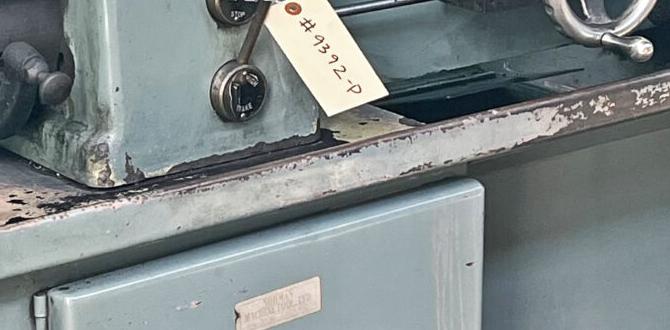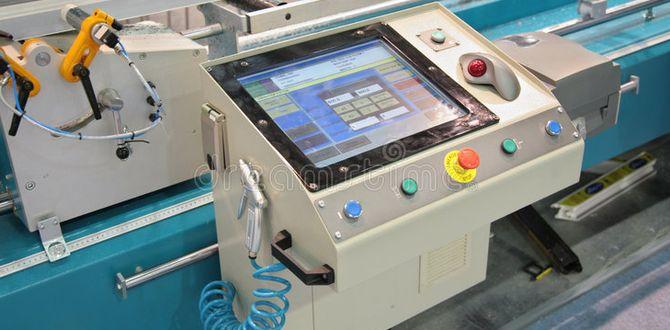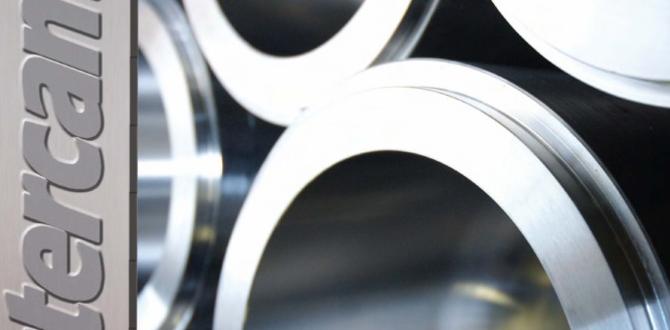Quick Summary:
For smooth, precise FR4 finishing, a Tialn ball nose end mill with a 40-degree helix angle offers excellent chip evacuation and surface quality. It’s ideal for detailed work on printed circuit boards (PCBs) and other fine FR4 routing tasks, minimizing fraying and ensuring clean edges.
Achieving Pristine FR4 Finishes with Your 40-Degree Tialn Ball Nose End Mill
Hey makers! Daniel Bates here from Lathe Hub, ready to tackle another common workshop challenge. Have you ever been frustrated by rough edges or lifted fibers when routing FR4, especially after intricate work? It’s a common hiccup, but one we can easily overcome. Today, we’re diving into how to use a 40-degree Tialn ball nose end mill to achieve beautiful, clean finishes on your FR4 projects. Think of this as your go-to guide for making your FR4 work look as professional as it feels. We’ll break it down step-by-step, so you can confidently achieve those glass-smooth edges every time.
Why FR4 Finishing Matters
FR4, that familiar fiberglass composite used in printed circuit boards (PCBs) and other applications, can be a tricky material to machine. When you’re aiming for fine details or smooth surface finishes, especially in hobbyist electronics or custom enclosures, rough edges can really detract from your work. The delicate glass fibers can fray or lift, creating a ragged appearance that’s both unsightly and potentially problematic for sensitive components. Getting a clean edge isn’t just about looks; it’s about precision and reliability in your builds.
Understanding the 40-Degree Tialn Ball Nose End Mill
So, what makes a 40-degree Tialn ball nose end mill so effective for FR4? Let’s break it down.
Ball Nose End Mill Explained
A ball nose end mill is like a pencil eraser on the tip – it has a hemispherical end. This rounded tip is perfect for creating rounded internal corners, contouring, and, crucially for us, achieving smooth surface finishes. Unlike flat-bottomed end mills, the ball nose distributes the cutting load more evenly across its surface, which helps with a smoother cut.
The Significance of the 40-Degree Helix Angle
The helix angle refers to the angle at which the cutting flutes spiral around the tool. For FR4, a 40-degree helix angle is often a sweet spot.
Improved Chip Evacuation: A steeper helix angle (like 40 degrees) helps the chips – the small bits of material removed during cutting – lift out of the flutes and away from the cutting zone more effectively. This is vital for FR4, as built-up chips can cause overheating and lead to melting or excessive fraying.
Smoother Surface Finish: The way the 40-degree angle interacts with the material can lead to a more consistent, polished-looking surface compared to tools with very steep or very shallow helix angles on FR4.
Reduced Vibration: This angle can also help dampen vibrations during the cut, contributing to a cleaner, more accurate finish.
The Role of Tialn Coating
Tialn (Titanium Aluminum Nitride) is a PVD (Physical Vapor Deposition) coating applied to cutting tools. It’s known for its:
Enhanced Hardness: Tialn increases the surface hardness of the end mill, making it more resistant to wear and abrasion. This is important for FR4, which can be abrasive due to its fiberglass content.
Increased Thermal Resistance: The coating helps the tool withstand higher temperatures generated during cutting, preventing premature wear and maintaining sharpness.
Reduced Friction: Tialn coatings can lower friction between the tool and the workpiece, leading to cleaner cuts and less material buildup.
Combining these features – the ball nose shape, the 40-degree helix angle, and the Tialn coating – gives you a robust tool specifically designed to handle the demands of FR4 machining for superior finishing.
When to Use Your 40-Degree Tialn Ball Nose for FR4
This specialized end mill is your go-to for tasks requiring precision and a high-quality surface finish on FR4.
PCB Routing: Creating precise cutouts for circuit boards, where clean edges are crucial for component placement and electrical integrity.
Engraving and Carving: Intricate designs or text directly onto an FR4 surface. The ball nose allows for depth variations and smooth curves.
Contouring and Profiling: Shaping the edges of FR4 parts to achieve specific profiles or rounded aesthetics.
Creating Small Radii: Machining internal corners with small radii that a standard end mill can’t achieve.
Surface Finishing Passes: A light finishing pass with a ball nose can dramatically improve the appearance of an FR4 surface that might have been roughed out with a different tool.
For a visual reference on different end mill types and their geometries, check out this helpful diagram from Machining Doctor.
Setting Up for Success: Essential Steps
Before you even power up your machine, proper setup is key to unlocking the potential of your 40-degree Tialn ball nose end mill.
1. Secure Your Workpiece
This is paramount for safety and accuracy. FR4, especially smaller PCB blanks, can chatter or vibrate if not held down firmly.
Clamping: Use appropriate clamps that grip the FR4 securely without putting excessive pressure on delicate areas. For PCBs, consider using a sacrificial spoilboard underneath and clamping both the FR4 and spoilboard together.
Vise: A milling vise can work, but ensure you use soft jaws or protective material to avoid crushing the FR4.
Double-Sided Tape: For very thin or small pieces, a high-strength double-sided tape can be effective, especially when combined with a spoilboard.
2. Mount the End Mill Correctly
A properly mounted end mill ensures stability and prevents runout (wobble), which is detrimental to finish quality.
Collet/Holder: Use a clean collet or tool holder that matches the shank diameter of your end mill. A worn or dirty holder can introduce runout.
Secure Tightening: Firmly tighten the collet nut and tool holder to ensure the end mill is seated correctly and won’t slip during operation.
3. Define Your Zero Point (Work Zero)
Accurate positioning is crucial for your CNC program.
Edge Finder/Probes: Use an edge finder or a CNC probe to accurately locate the edges of your workpiece and set your X, Y, and Z zero points.
Indicator: For manual milling, a dial indicator is essential for finding true centers or edges.
Z-Axis Touch-Off: Carefully set your Z-axis zero using a touch-off tool. This tells the machine where the surface of your material is.
4. Review Your Tool Parameters
This is where we tell the machine how to use the tool effectively.
Spindle Speed (RPM): FR4 generally prefers higher spindle speeds. A good starting point for a 1/8” (3mm) or 1/4” (6mm) ball nose end mill on FR4 might be between 15,000 and 25,000 RPM.
Feed Rate: This is how fast the tool moves through the material. For finishing passes, you want to go slower to achieve a better surface. A starting point could be 20-50 inches per minute (ipm) or 500-1300 mm/minute, depending on your machine and the depth of cut.
Depth of Cut (DOC): For finishing passes, a very shallow DOC is best. Think 0.002” to 0.010” (0.05mm to 0.25mm). This allows the tool to skim the surface and give that polished look. For full depth cutting, you might need multiple passes.
Stepover: This is how much the tool moves sideways between passes. For a finishing pass, a smaller stepover (e.g., 10% to 25% of the tool diameter) will give a smoother result. For roughing, you might use a larger stepover (e.g., 50%).
Important Note: These are starting points! Always consult the end mill manufacturer’s recommendations if available. It’s always best to perform a test cut on a scrap piece of FR4 first to dial in your settings.
Machining Strategies for Optimal FR4 Finishing
With your setup complete, let’s look at the techniques that will yield the best results.
Using a Ball Nose for Finishing Passes
The beauty of the ball nose end mill lies in its ability to create a smooth surface. When used as a finishing tool, the round tip creates overlapping scallops that, when small enough, blend together to form a smooth surface.
Light Depth of Cut: As mentioned, very shallow DOC is key. This isn’t about removing large amounts of material; it’s about “skimming” the surface.
Small Stepover: A fine stepover ensures that the scallops created by the ball nose are close together, minimizing the visible texture. For a truly polished look, you might use a stepover as low as 5-10% of the tool diameter.
Multiple Passes: For significantly uneven surfaces or when transitioning from a rougher tool, multiple finishing passes are beneficial. The first pass can clean up major inconsistencies, and subsequent passes refine the surface.
Toolpath Generation in Your CAM Software
Your Computer-Aided Manufacturing (CAM) software is where you define how the tool moves. For FR4 finishing with a ball nose:
Parallel Toolpath: This strategy creates a series of parallel passes across the surface of your model, ideal for general surface finishing.
Contour Toolpath: Useful for machining the edges of your FR4 parts or for finishing along a specific curve.
Scallop Toolpath: Similar to parallel, but often optimized for maintaining a consistent scallop height.
Ball Nose Specific Strategies: Many CAM packages have advanced strategies like “Ari” or “Spiral” contouring that are specifically designed to leverage the capabilities of ball nose end mills for high-quality surface finishes.
Understanding toolpath strategies is crucial. For more on this, Autodesk offers great introductory resources on CAM toolpaths.
Considerations for Different FR4 Thicknesses
The thickness of your FR4 sheet will influence your machining strategy:
Thin FR4 (e.g., 1-2mm): Use a rigid setup. Very light depths of cut and feed rates are essential to prevent flexing and chattering. Routing full depth in one pass might be too aggressive. Consider multiple shallow passes.
Standard FR4 (e.g., 1.6mm for PCBs): You have more flexibility, but consistency is still key. A well-supported FR4 can often handle slightly more aggressive cuts, but for finishing, shallow depths and fine stepovers remain the rule.
Thick FR4 (e.g., 5mm+): For thicker boards, you might use a larger diameter end mill for initial roughing and then switch to your 40-degree ball nose for the final finishing passes to achieve the desired surface quality. The principles of shallow DOC and fine stepover still apply.
Comparing with Other End Mill Types for FR4
It’s useful to know why your Tialn ball nose is superior for finishing compared to other common end mills.
| End Mill Type | Best For FR4 | Pros for FR4 | Cons for FR4 |
| :—————- | :——————————————————————————————————- | :—————————————————————————————————————– | :———————————————————————————————————————————————- |
| 40-Degree Tialn Ball Nose | Pristine surface finishing, intricate details, engraving, rounding internal corners. | Excellent surface finish, good chip evacuation, durable coating, creates smooth contours. | Can be slower for bulk material removal; smaller diameter tools can be less rigid for heavy cuts. |
| Flat End Mill | Slotting, pocketing, general contouring. | Good for removing large amounts of material quickly; straight edges for pockets. | Cannot create internal rounded corners; surface finish can be striated or fibrous with insufficient settings; less ideal for smooth surface texture. |
| Corner Radius End Mill | Machining slots and pockets with a specific internal radius. | Prevents stress concentration at internal corners; allows for larger corner radii than a ball nose. | Surface finish can still be striated; not designed for overall surface polishing like a ball nose. |
| Compression End Mill | Used on clad materials like FR4 to get a clean cut on both top and bottom surfaces simultaneously. | Clean top and bottom cuts on thin FR4, reducing fuzzing; good for sheet goods. | Not a ball nose, so not ideal for rounded profiles or intricate detail finishing; can be prone to burning if feed rates are too slow. |
The key takeaway is that while other end mills are excellent for specific tasks, the 40-degree Tialn ball nose is your specialist for achieving that smooth, professional finish on FR4.
Troubleshooting Common FR4 Machining Issues
Even with the right tools, you might run into problems. Here’s how to fix them:
Fraying or “Fuzzies” on Edges:
Cause: Tool dullness, too high a feed rate, too shallow a helix angle for the material, material holding not rigid enough.
Solution: Ensure your end mill is sharp. Slow down your feed rate. Try a finishing pass with a very shallow DOC. Improve workholding. Consider a higher helix angle if your tool has options.
Melting or Gumming Up:
Cause: Excessive heat, dull tool, insufficient chip evacuation.
Solution: Reduce spindle speed slightly (though FR4 likes speed, too much can hurt if not managed). Increase feed rate slightly. Ensure your chip evacuation is excellent (air blast, vacuum). Use a coolant/lubricant if your machine setup allows (be cautious with electronics). Ensure your Tialn coating is intact.
Chattering or Vibration:
Cause: Insufficient workholding, worn spindle bearings, loose end mill in holder, tool engaging too aggressively.
Solution: Secure your workpiece much better. Check your machine’s mechanical integrity. Ensure the end mill is tightly held. Reduce depth of cut and/or feed rate. A shorter tool stick-out can also help.
Poor Surface Finish (Scallop Marks Too Prominent):
Cause: Stepover is too large, depth of cut is too large, tool is dull, incorrect tool geometry for finishing.
Solution: Reduce the stepover significantly. Reduce the depth of cut to a whisper. Ensure the tool is sharp. You’re using the right tool in principle, so focus on the cut parameters.
Safety First!
Working with CNC machines and cutting tools requires vigilance. Always prioritize your safety:
Eye Protection: Always wear safety glasses. FR4 dust and small chips are sharp.
Hearing Protection: CNC machines can be loud.
Dust Extraction: FR4 dust is a fine particulate that you don’t want to inhale. Use a dust collection system.
Machine Guarding: Keep guards in place. Never reach into a running machine.
Emergency Stop: Know where your E-stop button is and how to use it.
Secure Fixturing: As emphasized, loose workpieces are dangerous.
For a comprehensive guide to CNC safety, the Occupational Safety and Health Administration (OSHA) has detailed standards for machine guarding that are highly relevant.
Frequently Asked Questions about 40-Degree Tialn Ball Nose End Mills for FR4
What is the ideal spindle speed for a 40-degree Tialn ball nose end mill on FR4?
For smaller diameter bits (e.g., 1/8″ or 3mm), start around 15,000-25,000 RPM. Higher speeds generally work well for FR4, but always test on a scrap piece. Consult the end mill manufacturer’s recommendations when available.
How do I avoid fraying when milling FR4 with a ball nose end mill?
Ensure your tool is sharp, use a fine stepover (10-25% of diameter) with a shallow depth of cut on finishing passes, and secure your workpiece very firmly. Proper chip evacuation is also key.
Can I use a 40-degree Tialn ball nose end mill for roughing FR4?
While it can remove material, it’s not ideal for heavy roughing. It’s designed for finishing. For roughing, you’d typically use a dedicated roughing end mill or a standard end mill with more aggressive parameters, followed by the ball nose for a finishing pass.





